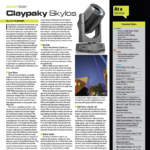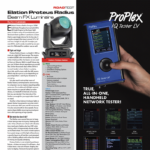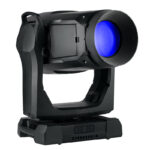PRG Nocturne has been producing touring video flypacks for control of their systems since the company’s inception, and by taking their 30-plus years of touring experience, they have created a new HD flypack system for video directors and engineers. The flypack is designed to deal handily with the rigors of loading and unloading on a daily basis, the demands of touring and the workflow of the video team.
The Typical Setup
While the HD flypacks can be configured for each tour, the systems start with a typical specification. A typical system consists of a Director’s Bridge, an Engineer’s Bridge, Transmission, Record/Playback, CCU, Re-clocker and Power Distribution racks, along with HD cameras. The actual configuration is arranged around the tour’s needs as well as the footprint backstage as well as the room they take up in the truck.
Starting at the Director’s Bridge, the switcher is a Grass Valley Karrera K-Frame S-series, which was built to PRG Nocturne’s specifications. The Karrera S-series switcher gets a lot more use on the road touring than Grass Valley’s broadcasting models. Most broadcast productions will sit for a week or more in one place; a tour loads in and out usually on the same day. The engineers and designers at PRG Nocturne have designed a rack system that allows each bridge to fold out of a single R&R Cases’ case and everything is ready to go. When it’s all closed up, it’s protected when packed in the truck. By having everything in a compact rack, the video team can set up in a smaller footprint backstage, in a hallway, in a bathroom, etc. It’s a glamorous life and production would like to give you the least amount of real estate possible backstage!
The cases are designed to work globally; with not just North American trucks in mind, but with the rest of the world’s truck dimensions and air cargo restraints in mind. Also, the cases can be stacked to take up less footprint in the truck.
Switchers and Racks
The switcher appears to be a 2 M/E (Mix/Effects) unit, but it’s actually a 4 M/E desk; it has two M/Es buried inside using the GV DoubleTake function. The system is designed for versatility and all the functionality the video team needs right at their fingertips. The director can control the cameras and video sources from this desk and the whole system is programmable through an on-screen display. The systems are built similarly for consistency but also with flexibility to customize as each crew sees fit. It’s all designed to save time and money not having to completely build a system for every tour.
The next rack over is the Engineer’s Bridge, where all of the technical functions of the cameras and the system are controlled. This rack houses the remote controls for the camera control units. The engineer can route any signal throughout the system and has control over a variety of technical functions including luminance and chrominance controls, color temperature, etc. This rack includes scopes to deal with proper camera shading as well as two color critical screens.
The next rack in the system that I walked through is the Record rack. This system had two Aja Ki Pro digital recorders and a pair of H.264 USB recorders. The system also includes timecode input and output and deals with audio signals for monitoring the show.
The Camera Control Units (CCU) rack is next in line and is designed for up to six cameras per rack. The rails and backplane are all hardwired into the rack so if one of the CCUs go bad, the whole control box is unscrewed, pulled out, and a new one is inserted in one simple and quick procedure. The box protects the brains and you’re not shipping an expensive control card around loose. If you don’t need that many cameras for a specific tour, the empty spots can be covered with blanks.
The next rack (Transmission) includes the processor for the GV Karrera switcher, up/down/cross convertors, frame syncs and distribution amplifiers. This is where all the cameras and sources come in as far as computers, cameras and playbacks. This rack also includes a large multiformat router to allow routing any source to projectors, LED screens, monitors, or processing/recording equipment. The router also provides backup switching capability in case of catastrophic failure. If the switcher fails, the whole show doesn’t stop. The router stays live and you can still get a signal; still operate a simple show. You won’t have transitions or effects like you would with the switcher, but you can still bring the camera feeds into the screen; you can still do a show. The routers and terminal gear are from Ross Video.
The next rack is the Re-Clocker rack that provides distribution and routing of all stage feeds and inputs. It also re-clocks the digital signals to allow additional length on signal cables as copper co-ax is limited by length because of the high frequencies needed for HD and 3G production. The rack includes a separate router and monitoring to provide quick troubleshooting at the stage area without trekking back to the transmission rack.
 New Cameras, Lenses
New Cameras, Lenses
The HD Flypack system also includes new Grass Valley cameras. They are deploying GV LDX-80 Première cameras that are paired with Fujinon lenses. These are professional-grade hard-body cameras that are designed for the rigors of touring. They are paired with 99x Fujinon long lenses or standard ENG lenses. They produce beautiful 1080i imagery, or can be switched between 1080i and 720p and stands up well to harsh weather and the tough conditions that are regularly encountered in touring productions. The camera has a very powerful feature set including a Contour Equalizer, which allows for tweaking the crispness in the shadows, mid-tones and highlights independently to better adapt the contour enhancements.
A lot of thought went into the packaging, not just with the rack dimensions, but in the airflow through the racks to keep the very expensive electronics gear cool and happy. The CCU rack in particular has channeling built in to channel the air in through the front at the bottom of the rack and up and across the electronics via designed ducting and out the top of the rear of the rack. It keeps the system working and upping the reliability. Having over 30 years of touring experience really pays off when designing these new flypack racks. The design helps improve load in and out times reducing the time you would need to build a system on show site as well as reducing the number of connections, or potential failure points in the video system.
This experience shows up in a simple touch for the intercom connection. The PRG Nocturne engineers got tired of the comms cable dragging across the control surfaces. The director and engineer’s bridges have a connector on the side of the control surface that has a passive cable running back to the Clear-Com station. This allows the video director and engineer to have their headsets plugged into the side of the control bridge without a cable to get in the way or created problems conflicting with the controls.
The PRG Nocturne HD Video Flypack system seems designed to make the lives of the video production team just that much easier as well as saving time and money on the road. I suggest that you take a closer look yourself.
At a Glance
Stunning Visuals, Road-Ready Package
PRG Nocturne’s HD flypacks typically consists of a Director’s Bridge, an Engineer’s Bridge, Transmission, Record/Playback, CCU, Re-clocker and Power Distribution racks along with HD cameras. The whole package is designed to be tour-ready, not just for the U.S. but for shows around the world, with an attention to details large and small to help make the touring life of the video road crew smoother as they serve up impressive visuals for big crowds of fans.
PRG Nocturne Karrera S-series SD/HD/3G Capable Video Flypack
PROS: PRG puts its 30+ years of touring experience to good use to make it easier to harness the latest visual technologies and incorporate them into a touring production. Even such minor details such as intercom connection placement have been considered and addressed.
CONS: None
TYPICAL RACK SETUP:
Director’s Bridge
Grass Valley Karrera K-Frame S-series Switcher (4 M/E).
Engineer’s Bridge
Controls luminance, chrominance, color temp, etc.
Transmission
Includes switcher processor, convertors, frame syncs, distribution amps.
Record/Playback
Two Aja Ki Pro digital recorders, two H.264 USB recorders.
Camera Control Units
Accommodates up to six cameras per rack.
Re-Clocker
Routes all stage feeds an inputs, re-clocks digital signals as needed.
Power Distro Racks
For power distribution.
TYPICAL CAMERA SETUP
Grass Valley GV LDX-80 Première cameras
Features include Contour Equalizer.
Fujinon Lenses
99x long lenses or standard ENG lenses.
MORE INFO: www.prg.com



